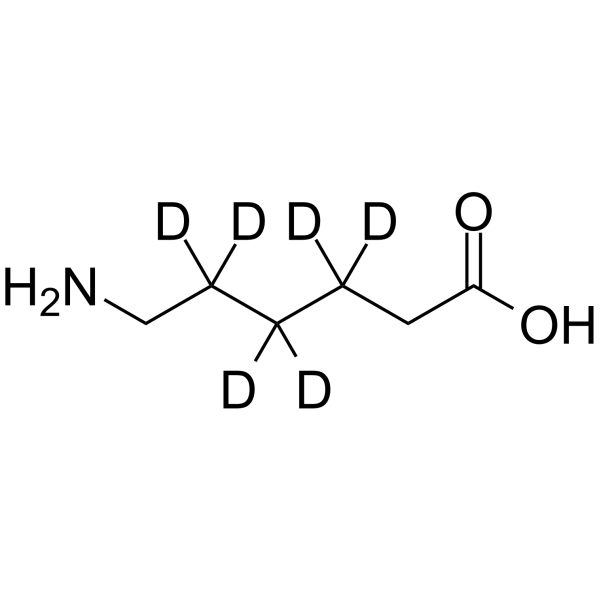6-Aminocaproic acid-d6
Modify Date: 2024-01-28 15:54:55

6-Aminocaproic acid-d6 structure
|
Common Name | 6-Aminocaproic acid-d6 | ||
|---|---|---|---|---|
| CAS Number | 1228656-08-3 | Molecular Weight | 137.21 | |
| Density | N/A | Boiling Point | N/A | |
| Molecular Formula | C6H7D6NO2 | Melting Point | N/A | |
| MSDS | N/A | Flash Point | N/A | |
Use of 6-Aminocaproic acid-d66-Aminocaproic acid-d6 is deuterium labeled 6-Aminocaproic acid. 6-Aminocaproic acid (EACA), a monoamino carboxylic acid, is a potent and orally active inhibitor of plasmin and plasminogen. 6-Aminocaproic acid is a potent antifibrinolytic agent. 6-Aminocaproic acid prevents clot lysis through the competitive binding of lysine residues on plasminogen, inhibiting plasmin formation and reducing fibrinolysis. 6-Aminocaproic acid can be used for the research of bleeding disorders[1][2]. |
| Name | 6-Aminocaproic acid-d6 |
|---|
| Description | 6-Aminocaproic acid-d6 is deuterium labeled 6-Aminocaproic acid. 6-Aminocaproic acid (EACA), a monoamino carboxylic acid, is a potent and orally active inhibitor of plasmin and plasminogen. 6-Aminocaproic acid is a potent antifibrinolytic agent. 6-Aminocaproic acid prevents clot lysis through the competitive binding of lysine residues on plasminogen, inhibiting plasmin formation and reducing fibrinolysis. 6-Aminocaproic acid can be used for the research of bleeding disorders[1][2]. |
|---|---|
| Related Catalog | |
| In Vitro | Stable heavy isotopes of hydrogen, carbon, and other elements have been incorporated into drug molecules, largely as tracers for quantitation during the drug development process. Deuteration has gained attention because of its potential to affect the pharmacokinetic and metabolic profiles of drugs[1]. |
| References |
[2]. Griffin JD, et, al. Epsilon-aminocaproic acid (EACA). Semin Thromb Hemost. Summer 1978;5(1):27-40. |
| Molecular Formula | C6H7D6NO2 |
|---|---|
| Molecular Weight | 137.21 |